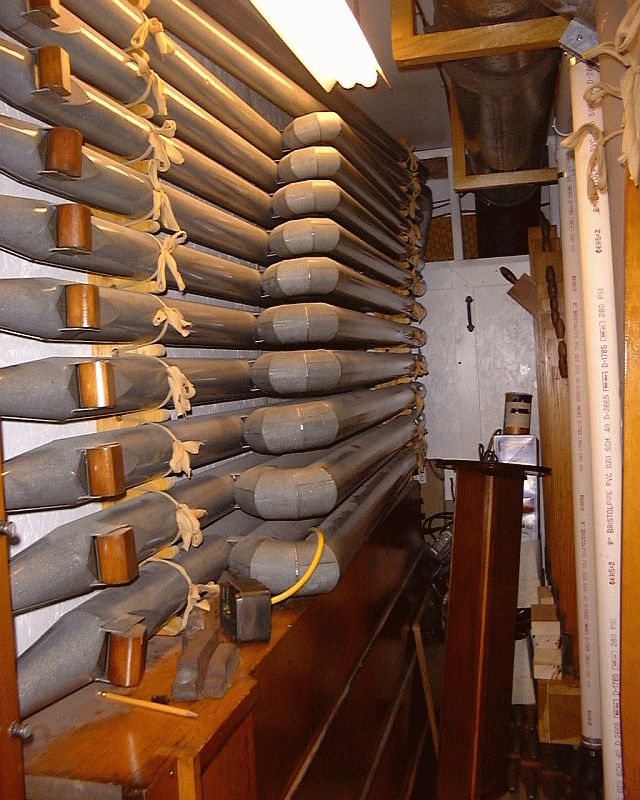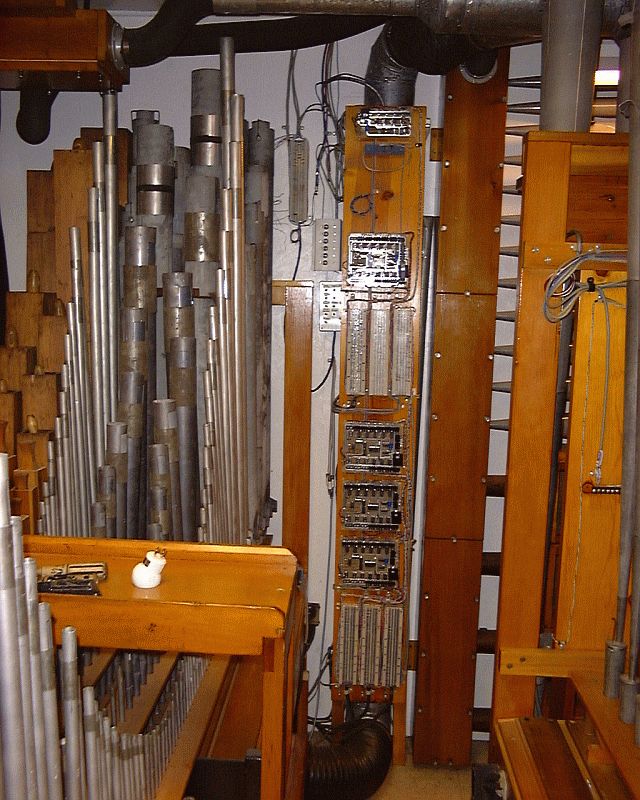 Installation
Information
Installation
InformationGeneral Information
 Installation
Information
Installation
Information
The instrument is currently installed in a single chamber in the basement of a townhome. The chamber has a 94-inch high ceiling. The chamber is "L" shaped with the major portion of the chamber measuring 16-feet long and 8-foot 8 inches wide. A small alcove for the 16' Tibia and Violin I pipes measures 7-feet long and 33-inches wide. The blower is located under a set of steps (shown at the "rear" of the photo on this page).
The chamber access door is only 16" wide to provide maintenance access to the instrument. Removal of the instrument will be effected through the shade opening with the blower having to be removed as a single unit (definitely the heaviest component to be removed). The motor can be removed along with some blower panels however the steel frame is still heavy. It is possible to totally disassemble the blower if absolutely necessary (it was brought in as a unit when I was much younger and had four people helping). The operating pressure of the instrument is about 6" water gauge.
The console was assembled such that it can be totally disassembled into the keydesk, side panels, and bottom panel once the stop rail and keyboards are removed along with the pedalboard. Where wiring has to be disconnected the use of telephone connectors or Type-66 punchblocks were used. Full documentation will be provided for the instrument's wiring.
The Z-tronics driver boards are wired to the chest direct electric magnets through a standard Type-66 telephone punch block. It is not necessary to remove the driver board panel from the chest as it should be possible to strap the driver board panel to the chest safely.
The smoked acrylic access panels are removable from the chests and once the two support bearers are removed each manual chest can be turned on end and carried out.
The shades are Moller, 12-stage. There are two shade frames.
The instrument is located in a basement. The shade opening is the rear of a bookshelf. The bookshelves are removable as is the grill cloth. Removal will require lifting the chests, blower, and other pipework to a height of 4-feet to clear the bottom of the shade opening and then lifting each item over the lower portion of the bookshelf. Once out of the chamber there is a set of stairs to navigate and then it is an easy move through the house to the front door and outside to a van. Four people minimum would be needed to remove the instrument with six being the recommended number.
There are a total of eight offset chests (16-note for the 16' Tibia & 16' Violin I, 14-note for the 8' octave pipes of the Diapason, Tibia, Violin I, and Violin II, two 5-note chests for the 8' octave of the Trumpet, 6-note, 4-note, and 2-note offsets for the 16' Concert Flute, and a 12-note for the 8' Concert Flute). There is one reservoir, one regulator, and two book-regulators.
 Extra
Pipework & Parts
Extra
Pipework & Parts
After the instrument was playing three ranks of Kimball strings became available. These are in storage and are intended to replace the Moller strings which are in "fair" condition. New rack boards will need to be made to hold the Kimball strings. The Kimball ranks consist of an Aeoline, Dolce, and Dolce Celeste. There is also a Skinner Oboe (needs some body & fender work) that will go with the instrument along with an unknown manufacturer open flute rank. Finally, an 8' octave of a Haskell string will be included (it is the match rank to the Haskell bases that are used with the Viola. The extra pipework will ONLY be sold with the instrument. The seller is not looking to break up the instrument at this time.
Also in storage are some offset chests and small reservoirs along with other odds and ends.
Along with the instrument will go an assortment of miscellaneous parts including Austin Pedal Actions (used for some of the offset chests), leather, felt, and supplies.
Conditions of Removal
The buyer will be responsible for the complete packing and removal of the instrument. As the instrument is disassembled it will need to be removed from the townhome as there is little storage space in the basement or on the first floor due to furniture. The buyer will be responsible to supply all packing materials and moving supplies as well as providing protection to the furniture and other townhome contents. The townhome owner will remove all books from the book shelves and the shade opening grill cloth to provide access to the instrument for removal.
Any damage to the townhome will be the responsibility of the instrument's purchaser to have properly repaired/corrected to the owner's satisfaction. The instrument shall be removed at one time (i.e. removal can not be spread over multiple non-consecutive days). The buyer accepts all responsibility to repair any and all damage done to the townhome. The buyer accepts total liability and responsibility for any and all injuries to those assisting the buyer in the removal. The instrument's current owner will be available to answer questions and explain how the instrument might be disassembled for easy reinstallation and will not assist with the instrument's physical removal.
The extra ranks of pipes and chests are located in an attic. The owner will pass these materials down through a ceiling access panel for the purchaser to pack and remove. This material will need to be moved down a set of stairs for removal from the townhome. The purchaser is responsible for removing all pipe organ related items including existing airlines, and support lumber.
Price Considerations & Making An Offer
The owner will
consider any reasonable
offer for the instrument as is. Obviously pipe organs contain various metals
including lead, tin, copper, and zinc which can be recycled. In addition
the direct electric chest action can be reused as can many of the console parts
and the electronic relay controlling it all. The blower and wind system
components can all find use in other instruments and thus have a "used" value.
If one reviews current pipe organ supply house prices, it will easily be seen
that ranks of pipes are $1,000 and higher. The direct electric actions in
the chests and console are tens of dollars per note/stop. It all adds up
but the fact that its used can't be overlooked either. In the final
analysis the sale of the instrument will be to the individual with an idea of
its worth as is, along with the knowledge and promise that it will be used and
enjoyed vs broken up for parts and pieces. Payment shall be by certified check or similar secure method. A
non-refundable deposit of $1,000.00 shall hold the instrument for the prospective
buyer for a period of 30-days from the date the check is deposited. Full
payment shall be made before the instrument may be removed. Removal date
is negotiable but needs to occur within a month of agreeing to purchase the
instrument. The instrument is currently playable and inspection can be
arranged prior to removal.
Contact Please contact Robert E. Wilhelm, Jr. if you
have questions or wish additional information regarding this instrument.
Bob may be contacted by email at by clicking the email link below.